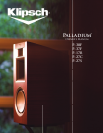
Page 16 Page 17
Loudspeaker Components -3Loudspeaker Components -2
Treble Compression Driver
Low distortion, high sensitivity, wide bandwidth and neutral tonality have been,
in this ground-breaking design, pushed beyond the standards for any previous
Klipsch driver.
Built around a .75-inch titanium dome, the tweeter makes use of two very large
high temperature N35H neodymium magnets in an unconventional congura-
tion. The titanium dome and surround are formed as one common unit.
The chamber behind the tweeter dome is resistively damped via a lled tube to
reduce reection of the back wave—and thereby the distortion that would otherwise be produced.
The phase plug that puts the dome into a compression mode also has a unique chamber within it that extends
the upper frequency limit of the driver. This proprietary technique oers numerous benets, including the elimina-
tion of undesirable standing waves in the high pressure layer between the phase plug and horn. The result is a
smooth impedance transfer function, and a benign load on the partnering amplier. Additionally, this technique
produces smoother amplitude response through the high frequency range. With its unique horn and phase plug,
the tweeter demands far less drive current from the ampli-
er, so the driver can maintain full dynamic capability at any
volume level.
This driver is inherently at from 3 KHz to 30 KHz. and has an
inherent sensitivity some 10 dB greater than direct radiating
designs. Distortion is also reduced by a factor of 10 dB, against
conventional tweeters.
Crossover Network
Through very accurate driver engineering, the system oers excellent perfor-
mance without the need for corrections in the crossover network. A cross-
over should provide a smooth transition from driver to driver, allowing each
element to operate at its optimum performance within its designed frequency
range. This accomplished, the network can be a straightforward design and
use extremely high quality parts without imposing unnecessary budget con-
straints. A simple, elegant crossover also means the speaker will have a more
direct and coherent character as compared with products that must employ
complex networks to iron out their shortcomings. Polyester capacitors along
with all air-core inductors, ensure
best performance and longev-
ity. The network produces
a fourth-order electro-acoustic lter when combined with the
smooth, natural roll o of the drivers.
Cabinet
Functionally, any loudspeaker enclosure provides a mechanical placement
of each transducer, a method for suppressing acoustical radiations and a reso-
nant chamber to extend low frequency performance. The Palladium Series is
an artistic blend of beauty and functional performance. Its industrial design
was guided by the global consultancy of BMW Group DesignworksUSA.
Enclosure resonances can be suppressed through the geometry of the enclo-
sure and mass of the panels. The Palladium Series enclosures contain nonpar-
allel wall structures and thick, high mass walls. Nonparallel wall structures sig-
nicantly decrease standing waves. Cabinet wall
thicknesses are a minimum of 1-inch thick with
an even thicker front bae. Custom inner and
outer laminated panels sandwich a middle layer of dissimilar material designed with a
dierent mechanical impedance to ensure the cabinet does not color the sound.
To further increase enclosure stiness, “H” braces are strategically positioned in the
enclosure to reinforce the structure, control resonance and minimize modal stand-
ing waves. The massive front bae design allows all woofers and the mid/high horn
structure to mount ush to the exterior edge. The width of the front bae has also
been minimized to decrease the total area. A smaller front bae directly correlates
to improved o-axis performance. The overall enclosure was designed to extend the
low frequency response of the woofers. This fourth-order, vented enclosure contains
tuned ports cleverly blended into the rear of the enclosure. Just below the ports on
the P-38F and P-37F , a high mass aluminum and steel base is integrated into the
bottom of the enclosure. The base contains four adjustable oor anchors, which
decouple the cabinet from the oor by supporting the cabinet at just four points.
Tractrix® Horn Design
Horn-loaded technology is the driving force behind the remark-
ably accurate Klipsch sound. Horns oer high eciency, low
distortion, controlled directivity and at frequency response,
allowing them to more closely reproduce the quality and tonal
characteristics of live sound. In the Palladium Series, the high and
mid-frequency drivers both use the latest evolution of our Tractrix®
Horn design, featuring a 90° x 60° coverage pattern and a lofted
throat design for exemplary on-axis response. These horns have
been molded as a single unit, using a proprietary, acoustically in-
ert, carbon-infused thermoset composite material. The high- and
mid-frequency drivers are connected to the horns via chamber-
dampened phase plugs that result in a 4:1 compression ratio,
delivering remarkable eciency with astonishingly low distortion.
This arrangement allows the Palladium Series to provide a unique
combination of precision, clarity and eortless power.
Bass Network
Mid and Treble Network













